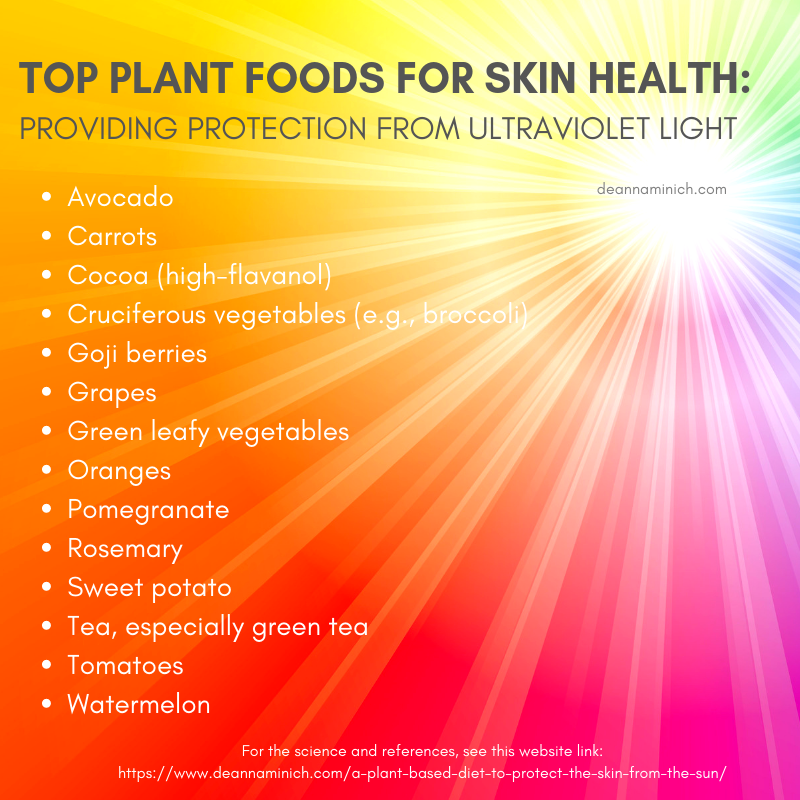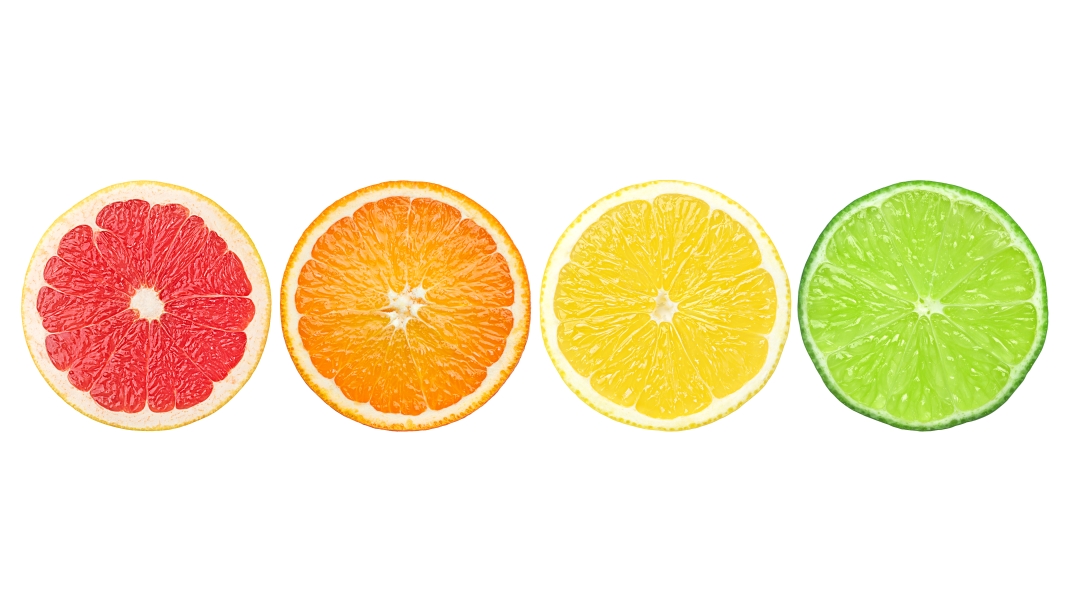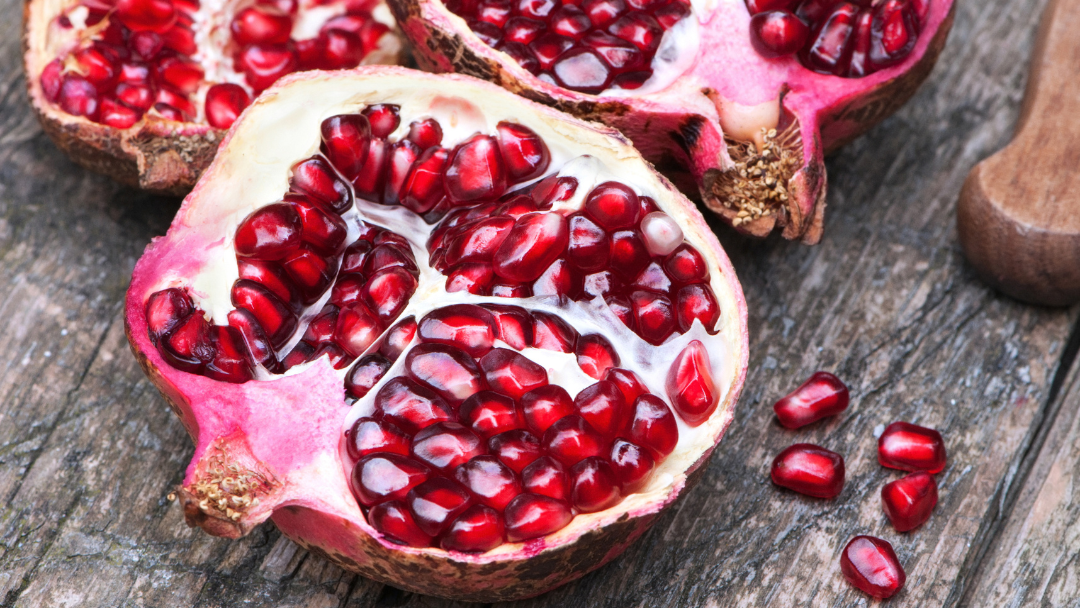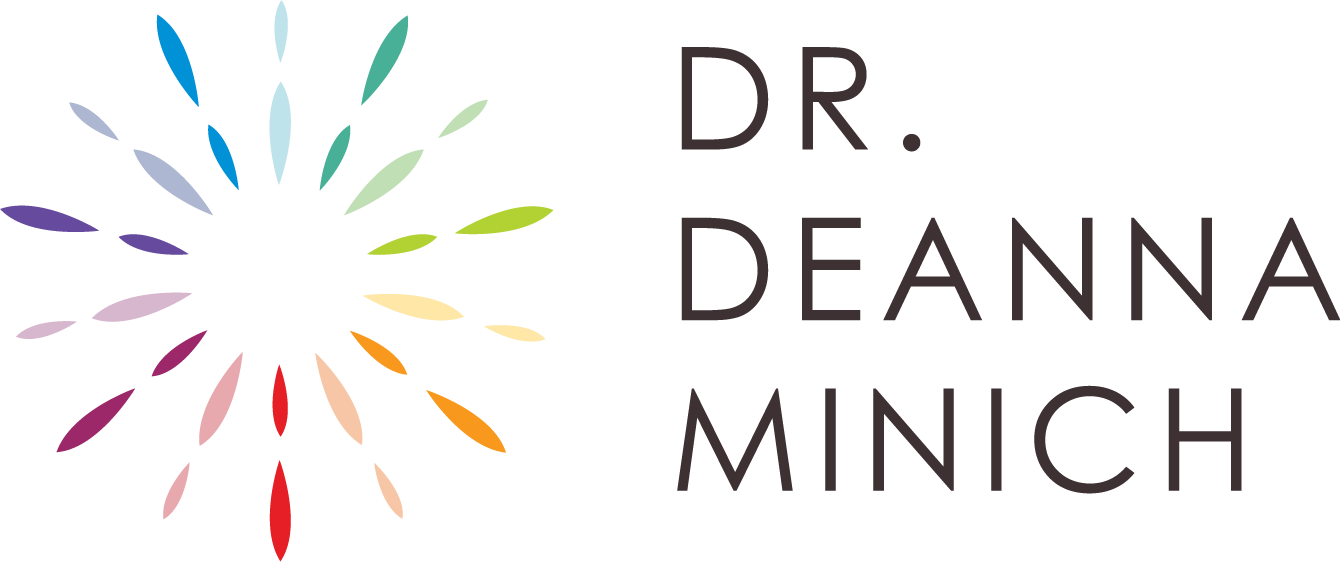Photo: grey_and/Shutterstock.com
It’s summer, so the days are warmer and longer, the perfect combination for fun outdoor activities…and a greater potential for damage from the sun’s UV rays, including sunburn, skin aging, and an increased risk for skin cancer. Protecting against damage from the sun can be complex, especially as some common sunscreens have risky ingredients, such as oxybenzone. Ultimately, you have to weigh the risks with the benefits before coming to your own personal decision on the best barrier protection for you.
Physical or chemical barriers can help protect against sun damage, but they are not the only tools you can have in your arsenal. The foods you consume may provide additional protection, especially if you choose some of the foods that act as internal sunscreens that mitigate the damage from the UV rays.
My personal approach to sunscreen is to take an internal and external approach. Not only is it important to consider all of the issues with sunscreen ingredients, but we need to fortify the skin internally with plant-protective nutrients like carotenoids. Colorful pigments in plants, as well as vitamins C and E, together with polyphenols, have been shown to target several reactive oxygen species and decrease oxidative stress and subsequent inflammation, as well as prevent damage to collagen and elastin proteins in the skin cells and prevent changes to cellular DNA.
Eating a plant-based diet may help with internal photoprotection through the localization of these compounds into the epidermis, and in some skin types, such as in lightly-pigmented Caucasian skin, may create a slight “yellowing” that would correlate with photosensitivity: more yellowing, less photosensitivity.
Let’s break down what else the literature has to say about the different dietary elements that provide some photoprotection you need to include in any diet to protect the skin.
Carotenoids: Beta-Carotene and Lycopene
One of the best-researched plant components with photoprotection qualities are carotenoids, especially beta-carotene and lycopene. These two exist in higher levels in the skin compared to lutein and zeaxanthin and other carotenoids, making them a good target for photoprotection, especially as they can absorb UV rays. In plants and other photosynthetic organisms, carotenoids collect certain wavelengths of light as part of photosynthesis, providing some protection for these organisms as well. Carotenoids in the skin likely have a similar protective role. The various carotenoids have different capabilities for protection and absorption, and it is not just about the color; even the colorless carotenoids phytoene and phytofluene absorb UV radiation.
In addition to absorbing light, carotenoids also aid in protection against sun damage through their antioxidant properties. They can inhibit lipid peroxidation, attenuate DNA-damage, and reduce inflammation. Additionally, provitamin carotenoids aid in producing retinoic acid for further skin health benefits.
Some studies demonstrate the capacity for orally consumed carotenoids to provide photoprotection. In one double-blind, randomized, placebo-controlled study, participants took either two soft gel capsules containing 7.5 mg lycopene, 2.9 mg phytoene and phytofluene, 0.4 mg beta-carotene, 2.8 mg tocopherols from tomato extract, and 2 mg carnosic acid from rosemary extract per capsule or a placebo containing medium-chain triglycerides for 12 weeks. Although there was no significant difference in MED (minimal erythema dose, a measurement for sensitivity to sunburn), the treatment group did experience a significant increase in protection against UVB-induced erythema (reddening of the skin) formation and protected against upregulation of inflammatory cytokines (specifically IL6 and TNF alpha). There was also an increase in plasma levels of carotenoids in the treatment group.
Another study found that 12 weeks of supplementation with 20mg of lutein syrup, administered daily, showed a 22% improvement in photoprotection against UV-induced erythema from baseline compared with a placebo group. In another placebo-controlled, double-blinded, randomized, crossover study, taking lycopene-rich tomato nutrient complex and lutein supplements for 12 weeks demonstrated the potential to protect against the oxidative stress, photodermatoses, and photoaging due to sun exposure.
A prospective, single-arm, open- label study looking at 16 Japanese participants administered 20 mg/d of lutein and 4 mg/d of zeaxanthin, along with a mix of vitamin C, vitamin E, zinc, and copper, demonstrated a mean increase in dermal carotenoids of 48%. A double-blind study looking at the synergistic effect of carotenoids and antioxidant vitamins found that the combined supplementation of 12.75 mg β-carotene, 3.30 mg α-carotene, 3.36 mg lutein, and 0.16 mg zeaxanthin significantly reduced UVA-induced pigmentation, UVB-induced erythema, and increased in dermal antioxidant levels. The synergistic work between carotenoids and antioxidant vitamins may provide further photoprotective benefits and, when taken together, have been reported to be protective against UV damage.
Polyphenols, Flavonoids, and other Phytochemicals
Carotenoids are not the only plant-based compounds that protect against sun damage; phytochemicals such as polyphenols and phenolics provide photoprotection through UV-absorption, anti-inflammatory properties, DNA repair ability, and antioxidant ability as well.
Want another reason to add some dark chocolate to your diet? The flavonoids may protect against UV-caused skin damage. In one small study, consuming 4 – 6 g of cocoa for one week led to a statistically significant increase in photoprotection, although 1 gram was not effective. Another small study found that consuming 20 g of high-flavanol chocolate for 12 weeks led to a mean MED more than double of the baseline, which means a reduction in sunburn risk, while a group that consumed low-flavanol chocolate had no change. However, a separate study found no statistical difference between high-flavanol and low-flavanol chocolate, but it did not have a no-chocolate consumption group.
Other polyphenols and phytochemicals likewise have the potential to protect against sun damage. In one study, a dried melon concentrate rich in antioxidant capacity (15 U SOD/mg powder) in both oral supplementation and topical application led to an increase in MED, increase in endogenous antioxidant enzymes, and reduced sunburn formation. The group that used the cream and supplement had the best results.
One human study looking at the consumption of California table grape powder 3 times daily for 14 days, with each serving equivalent to three-quarters of a cup of fresh grapes, found improved MED and reduced markers of DNA damage, inflammation, and apoptosis. In a mouse study, grape seed proanthocyanins significantly inhibited the growth and multiplicity of UVB-radiation induced skin tumors.
In one randomized group study, participants took either 100 or 250 mg of Nutroxsun (a mixture of rosemary and citrus extracts) or a placebo daily at breakfast over a period of two months, with tests at 13 days, 1 month, and 2 months. In the group that took the supplement, MED increased by 4.0, 5.2, and 7.7 at 2 weeks, 1 month, and 2 months respectively in the 100 mg, with the 250 mg dose seeing an increase of 3.1, 5.5, and 7.5 respectively, with no statistical significance between the doses. There was also a decrease in oxidative stress markers, wrinkle depth, and skin elasticity. This study also looked at short-term intake and did not find the same results.
In one prospective study looking at 63,257 men and women who were 45 to 74 years old found that regular consumption of caffeine from coffee and tea reduced the risk of non-melanoma skin cancer, basal cell carcinoma, and squamous cell carcinoma. In a cross-sectional study looking at polyphenol consumption and photodamage, women consuming coffee and green tea regularly had lower rates of hyperpigmentation spot development. The polyphenols found specifically in green tea may also be beneficial for photoprotection. One small study found that taking a supplement with 540 mg green tea catechins and 50 mg vitamin C daily for 12 weeks decreased erythema after exposure at the maximum UVR dose. There was also a reduction in the inflammatory response.
Vitamins C and E
In addition to the phytochemicals above, certain vitamins, especially those known for their antioxidant and skin-promoting properties, may also aid in protecting against UV-induced skin damage and aging. The two best studied in connection with photoprotection are vitamins C and E, although the results are mixed.
In one population study, higher dietary intakes of vitamin C led to a decreased odds ratio of melanoma (0.86 and 0.59 for the intermediate and highest categories respectively). In another study, taking 1,200 IU of d-alpha-tocopherol led to an increase in median MED from 60 to 65 mJ/cm2, while that plus 2 g of ascorbic acid led to an increase from 50 to 70 mJ/cm2. Those taking just vitamin C did not have any significant changes. Another study likewise found a combination of 2 g of ascorbic acid combined with 1,000 IU of d-alpha tocopherol after eight days led to an increase of MED from 80 to 96.5 mJ/cm2, while the placebo group experienced a decline in MED from 80 to 68.5 mJ/cm2.
Additional Sources for Internal Photoprotection
There may be additional components to consider adding to your list of internal sunscreen methods, including fish oil and probiotics.
The anti-inflammatory properties of fish oil, specifically the omega-3 fatty acid EPA, might also help reduce some of the impacts of UV rays on the skin. In one double-blind, randomized controlled trial, 12 weeks of 1 g fish oil gelatin capsule with an estimated 70% EPA and 10% DHA reduced some of the inflammatory responses in the skin after exposure to UV radiation simulating that of the sun. In a mouse study, mice supplemented with n-3 PUFA-FO for 2 weeks demonstrated reduced UVB-induced photodamage and accelerated sunburn wound healing. The administration of n-3 PUFA-FO reduces inflammation intensity and increases dermal antioxidant activity. Maresin 1 (MaR1) is an anti-inflammatory lipid mediator derived from the docosahexaenoic acid (DHA). A mouse study found that 10 ng/μL of MaR1 dosed 10 minutes before UVB radiation prevented oxidative stress and inflammation caused by UVB exposure.
The gut is not the only place in which beneficial bacteria may play a role in health; the skin also has its own microbiome. Recent research is pointing to the potential for oral administration of certain strains of commensal bacteria to provide some photoprotection in the skin. In one mouse study, Bifidobacterium breve strain Yakult (not to be confused with the Yakult drink) for 9 or 14 days led to a reduction in skin damage after exposure to UV light for 4 consecutive days. Research has demonstrated that Lactobacillus acidophilus IDCC 3302 can restore collagen expression after UV irradiation, suppress MAPK signaling pathways (pathways involved with the cellular response to UV rays), and reduce inflammatory responses activated by UV exposure. Another mouse study, whether a prebiotic, galacto-oligosaccharide (GOS), and probiotic Bifidobacterium longum either together or separate provided help and found that just the prebiotic, GOS, led to a reduction in erythema formation and photoaging.
The Best Phytoprotective Foods to Incorporate in Your Diet
Many of the items listed above have additional health benefits, so their capacity to provide some photoprotective benefits just adds another reason to incorporate them into your diet. That being said, most of the evidence listed above demonstrating the benefits of taking these relied on high doses as a supplement rather than dietary intake. However, one review article found the greatest promise in terms of preventing skin cancer came from whole foods rather than supplements, likely due to synergistic effects. It is important to note that there are studies that demonstrate no benefit or inconclusive results, and supplementation and diet cannot replace the protective effects of sunscreen.
You may find that the evidence pointing to a potential benefit is enough to consider adding these components to a varied, plant-based, colorful diet. Some of the best foods that have either been researched in connection with photoprotection or are simply rich in one or more of the elements above to include in a photoprotective diet include:
- Avocado
- Carrots
- Chocolate, especially high-flavanol cocoa
- Cruciferous vegetables (e.g., broccoli)
- Goji berry
- Grapes
- Green leafy vegetables
- Pomegranate
- Rosemary
- Sweet Potato
- Tea, especially green tea
- Tomatoes and tomato products
- Watermelon
The photoprotective benefits from these foods and others rich in carotenoids, polyphenols, vitamin C, vitamin E, and additional protective nutrients may not be enough to completely replace physical barriers such as clothing or some type of topical sunscreen, especially in those at a higher risk of damage. However, these nutrients also provide benefit to the skin beyond just protection against the sun, as well as other health benefits.
To get the most out of consuming a photoprotective diet, focus on long-term, daily consumption as part of your regular diet. It may not be enough to eat these foods only on days you know you will be in the sun. As always, talk to your doctor or another healthcare practitioner about your unique situation, risk of UV damage, and the best of these foods to incorporate in your diet based on your own circumstances.
As far as external sunscreen, the best solution is to visit the Environmental Working Group’s website and look at the toxicity and safety of thousands of sunscreen and skin-care products, including possibly some of your favorites. They also publish a sunscreen guide every year that includes recommendations based on different categories, such as beach and sport, kid’s, and moisturizers with SPF. This guide can help you to be a more informed consumer without having to do too much research of your own.
If you have a skin disorder or some health concern that may make you more susceptible to chemicals and even some of the safer ingredients in personal-care products, be sure to discuss the use of these products with your doctor or another healthcare provider.






